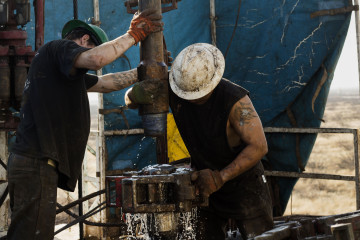Texas Refiners Work on Harvey Recovery as More Storms Loom

published Sep 4, 2017 5:34:59 PM, by Amy Stillman
(Bloomberg) —
As much of the U.S. shut down for Monday’s Labor Day holiday, Gulf Coast refiners continued their recovery from the devastation of Hurricane Harvey.
Valero Energy Corp. returned two Texas refineries to pre-storm fuel-making rates while three other plants were in various stages of resuming operations, said Lillian Riojas, a spokeswoman for the San Antonio-based company. Exxon Mobil Corp. began shipping gasoline and diesel in Houston-area pipelines, although its Beaumont, Texas, refinery was too flooded to turn back on. Flint Hills Resources LLC and Citgo Petroleum Corp. also were in the process of resuming production, according to Genscape Inc.
Gasoline futures surged to a 26-month high last week as Harvey’s churn across southeast Texas and Louisiana knocked out refineries, pipelines and ports responsible for producing and dispatching much of the continent’s gasoline, diesel and jet fuel. The rally began to fizzle as domestic refiners bailed out swamped plants and resumed operations, while European and Asian traders swooped in with cargoes to capture profits. The roller-coaster may continue, with another major hurricane moving across the Atlantic Ocean toward the Caribbean.
“We have seen a fair amount of refinery capacity return online but there still is a significant amount that is still offline between the Houston-Beaumont-Port Arthur region,” Andy Lipow, president of Lipow Oil Associates LLC in Houston, said by telephone. “The market is pricing in a rather quick recovery in the Houston area but it might still be several weeks for the Houston area refiners to return to full production.”
Gasoline futures for October delivery declined by 3.3 percent Monday to $1.6906 a gallon, the lowest in more than a week. The price reached its post-Harvey peak on Aug. 31 when the futures jumped 14 percent to close at $2.1399.
Harvey made landfall twice along the U.S. Gulf Coast, bringing torrential flooding that shut pipelines and took about 3.53 million barrels, or 19 percent, of daily U.S. refining capacity offline, data compiled by Bloomberg show. The Energy Department approved the release of 5.3 million barrels of crude from the Strategic Petroleum Reserve to aid refiners whose oil deliveries were interrupted by the storm.
Irma Threat
Hurricane Irma strengthened to a Category 4 storm with top winds of 130 miles an hour (215 kph) and is expected to approach the northern Leeward Islands late Tuesday or early Wednesday morning, according to an advisory on the National Hurricane Center website. The center also forecast a 50 percent chance of a group of thunderstorms in the southwest Gulf of Mexico developing further in the next five days. Irma may threaten the Gulf refining recovery, noted Lipow.
“Irma is a concern because it appears to be heading over Cuba and then into the Gulf of Mexico and could impact oil production and refineries once again,” he said. “This has not been reflected in the price quite yet because it is a ways out,” he added, but should it hit the Gulf coast in the next week “gasoline prices and oil prices will both increase.”
To contact the reporter on this story: Amy Stillman in Mexico City at astillman7@bloomberg.net To contact the editors responsible for this story: David Marino at dmarino4@bloomberg.net Joe Carroll
copyright
© 2017 Bloomberg L.P






No Comment